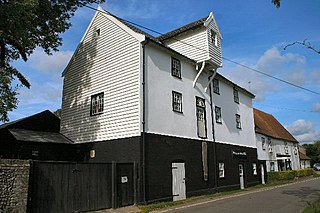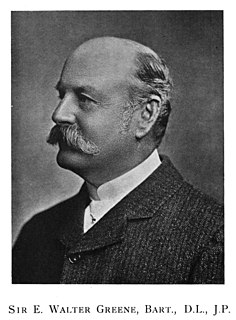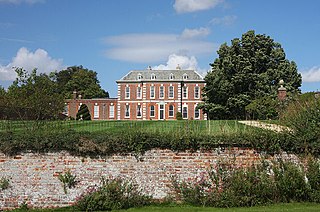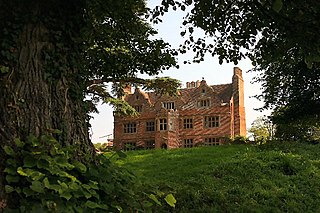
Nether Hall is a country house situated in the village of Pakenham, Suffolk. It was one of the ancient manors of the village and seat of the Greene baronets. [1]

Nether Hall is a country house situated in the village of Pakenham, Suffolk. It was one of the ancient manors of the village and seat of the Greene baronets. [1]
'Nether' refers to the Hall's 'lower' position in the village, compared to a superior Pakenham Hall that previously stood near Pakenham Wind Mill. Pakenham Hall was occupied by the Lord of the Manor of Pakenham - firstly the Abbot of Bury St Edmunds and then the Spring family - while Nether Hall was originally the seat of the de Pakenham family, ancestors of the Earl of Longford. [2] Nether Hall passed to Edmund de Pakenham in 1292, and when he died in 1332 to his widow, Rohais, or Rosia de Pakenham. After her death in 1352 it passed to her son, Edmund, and thence to his widow, Mary de Pakenham in 1360. [3]
The Manor of Nether Hall remained in the possession of the de Pakenham's for about six descents. Theobald de Pakenham, the last holder, died without male issue. His granddaughter, Margaret, married Sir William de Bardwell, the standard bearer to the Edward, the Black Prince. Nether Hall Manor then came into the possession of Bury St Edmunds Abbey. Following the Dissolution of the Monasteries it was acquired by Thomas Bacon and his son, George, who died in 1579. It then passed to his son and heir, John. This same Thomas Bacon, a member of a branch of the famous Bacon family of that era, was seated at Hessett. It was then purchased by the mercantile Bright family, who occupied Nether Hall for one hundred and sixty-four years. Robert Bright, the purchaser, is noted chiefly for the building of Newe House which was completed in 1622. He erected it originally to be his own residence; and his eldest, married son, Thomas lived in Nether Hall. Nether Hall remained in the possession of the Bright family until 1765. [4]
Mary Bright, daughter of the fourth Thomas Bright, was the last of the name to inherit Nether Hall. She married Edmund Tyrell, of Plashwood Hall, Haughley, in 1744, and the estate was inherited by their son, Edmund Tyrell, after the death of his father. This son, who had also inherited Plashwood Hall, sold the Nether Hall estate to George Chinery, of Bury St. Edmunds. In 1807 he left the Nether Hall estate to his nephew, the Rev. William Bassett, who was Rector of Thurston. His son, William C. Bassett succeeded by entail and was residing in Nether Hall in 1857. The Nether Hall Estate changed hands again in 1886 when it was purchased by William Hardcastle for £38,000. He never lived in Nether Hall, and he very soon sold it to Sir Edward Greene, 1st Baronet, the Member of Parliament for Bury St Edmunds. [5] When his son, Sir Raymond Greene, 2nd Baronet, died in 1920, the whole Estate was sold by his heirs to Mr A.J. Edwards, and then to the Martin family who modernised the interior of the building. Under the Martins Nether Hall became a country club of the Kristina Martin Charitable Trust. Nether Hall thus became a Country Club within the Trust. Mr Martin sold Nether Hall to the current occupants in 1987.

There have been three baronetcies created for members of the Bacon family, all in the Baronetage of England. As of 2008, one creation is extinct and two of the creations are extant. The extant titles have been merged since 1755.

Troston is a village and civil parish in the English county of Suffolk.

Long Melford, colloquially and historically also referred to as Melford, is a large village and civil parish in the Babergh district, in the county of Suffolk, England. It is on Suffolk's border with Essex, which is marked by the River Stour, just 3 miles (4.8 km) from Sudbury, approximately 16 miles (26 km) from Colchester and 14 miles (23 km) from Bury St Edmunds. It is one of Suffolk's "wool towns" and is a former market town. The parish also includes the hamlets of Bridge Street and Cuckoo Tye.

Pakenham is a village and civil parish in the West Suffolk district of Suffolk in eastern England. Its name can be linked to Anglo-Saxon roots, Pacca being the founder of a settlement on the hill surrounding Pakenham church. The village describes itself as the "Village of Two Mills", as it has a water mill which claims to be the only working example in the county, as well as a working windmill.

Redgrave is a village and civil parish in Suffolk, England, just south of the River Waveney that here forms the county boundary with Norfolk. The village is about 4 1⁄2 miles (7 km) west of the town of Diss. The 2011 Census recorded the parish population as 459.

Haughley is a village and civil parish in the English county of Suffolk, about two miles from Stowmarket in the Mid Suffolk District. The village is located 2 miles (3.2 km) miles northwest of the town of Stowmarket, overlooking the Gipping valley, next to the A14 corridor. The population recorded in 2011 was 1,638. Mentioned in the Domesday Book, it was the site of a castle, a church on the pilgrim's route to Bury St Edmunds Abbey, and a market. Adjacent farms on the north side of the village were also home to one of the first studies of organic farming and the first headquarters of the Soil Association.
This is a list of Sheriffs and High Sheriffs of Suffolk.

Hardwick House was a manor house near Bury St Edmunds, Suffolk, owned by Sir Robert Drury, Speaker of the House of Commons, of Hawstead Place. It was subsequently purchased in the seventeenth century by Royalist Robert Cullum, a former Sheriff of London. Experts in Suffolk county history as well as noted authorities in antiquarian and botanical matters, the Cullum family of eight successive baronets authored works on the county and its fauna and flora. Sir Thomas Gery Cullum, a Charterhouse graduate, medical doctor and member of the Royal Academy and the Linnean Society, was a well-regarded author on science and botany.
Sir Nicholas Bacon, 1st Baronet, of Redgrave, Suffolk, English Member of Parliament. In 1611 he was the first man to be created a baronet. Bacon would serve on many commissions. The Privy Council constantly called upon him to conduct inquiries. Bacon was a leader of puritanism in Suffolk. The power and prestige of the puritan ministries in many areas of the country owed their power to Bacon. Sir Nicholas Bacon was considered a good Christian by his contemporaries. Especially his chaplain, Robert Allen. Robert Allen stated that Sir Bacon's wife was dedicated to "God's holy religion and worship by every good and Christian means in the sight of men." Allen would even dedicate his Doctrine of the Gospel to Sir Nicholas and other members of the family.
Sir William Spring, 1st Baronet was an English Parliamentarian politician and a member of the Spring family of Pakenham, Suffolk.

Sir Edward Walter Greene, 1st Baronet was a British brewer and Conservative Party politician.

The Spring family is a Suffolk gentry family that has been involved in the politics and economy of East Anglia since the 15th century, as well as holding large estates in Ireland from the 16th century.

Dalham Hall is a country house and 3,300-acre (13 km2) estate, located in the village of Dalham, Suffolk, near Newmarket, and 13 kilometres (8 mi) west of Bury St Edmunds.
Sir William Spring of Lavenham was an English politician and landowner.

Nowton is a small village and civil parish in the West Suffolk district of Suffolk in eastern England. Located on the southern edge of Bury St Edmunds, in 2005 its population was estimated to be 140. At the 2011 census 163 people were recorded as living in the village.

Newe House is a Grade II* listed Jacobean dower house in the village of Pakenham, Suffolk.
Alderley Old Hall is the remaining part of a former 17th-century manor house near the village of Nether Alderley, Cheshire, England. It stands adjacent to the mill pond of Nether Alderley Mill, a loop of which acts as a moat. The hall is recorded in the National Heritage List for England as a designated Grade II* listed building.
Sir William Spring of Pakenham was a Suffolk gentry politician who sat in the House of Commons at various times between 1623 and 1629.
There have been two baronetcies created for persons with the surname Greene, one in the Baronetage of England and one in the Baronetage of the United Kingdom. Both creations are extinct.
Pakenham Hall was a manor house in Pakenham, Suffolk, the capital residence of Pakenham manor. It was demolished and replaced by a more modern house, now called Pakenham Old Hall, in 1900. It was the family seat of the Spring family between 1545 and 1735, and then of the Barons Calthorpe.